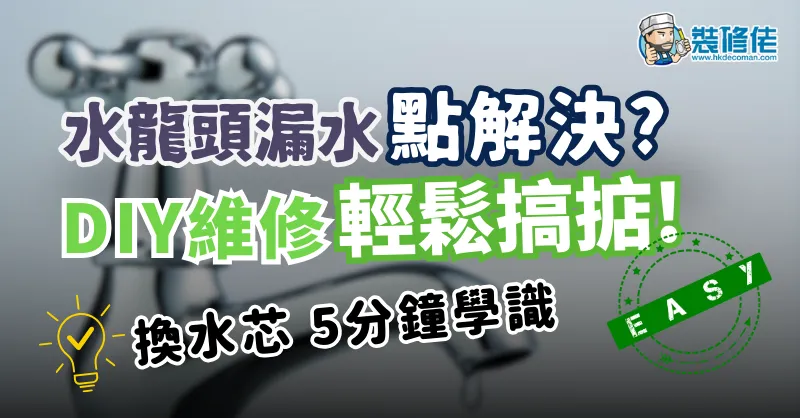Simple DIY: Fixing a Leaky Faucet
Listen to the blog audio:

Faucets are essential fixtures in our daily lives, and they are frequently used in the kitchen and bathroom. It is inevitable that they will suffer some wear and tear over time. A dripping faucet may seem like a minor issue, but it can be annoying in the long run, wasting water resources, increasing water bills, and even causing noise. However, as long as we identify the cause of the leak and understand the simple structure of a faucet, DIY repair is not as difficult as it seems. With the right tools and steps, we can not only fix the leak but also extend the lifespan of the faucet.

Reasons for Leaks
Faucet leaks are mostly concentrated in the following areas:
Aging Faucet Gasket
The rubber gasket inside the faucet (also known as the sealing ring) is the most susceptible to damage. Due to prolonged contact with water and friction during use, the rubber gasket tends to age and lose its elasticity or develop cracks. As a result, it can no longer effectively block the water flow, leading to leaks. This is especially common in faucets that have been in use for more than 3-5 years.
Loose Parts
The inside of a faucet consists of multiple parts, including the valve core, screws, handle (commonly known as the spoon handle), and more. During daily use, these parts may gradually loosen due to vibration or improper operation. Loose screws can create gaps between parts, allowing water to seep through. Moreover, long-term wear on metal parts can reduce the tightness of the seal, resulting in tiny leakage points.
Damaged Valve Core
The valve core (also known as the valve stem) is the crucial component that regulates water flow. If the valve core is rusted or damaged by impurities in the water, it may cause the faucet to become difficult to turn on or off smoothly or fail to shut off completely, resulting in leaks.

Emergency Response Handling
When you discover a leaking faucet, you can take the following temporary measures:
1. Turn off the water source
When you find a severely leaking faucet, the first step is to turn off the water control valve below the faucet or the main water valve for the entire unit. This action will immediately stop the leak from worsening, preventing further water wastage and potential property damage.
2. Inspect the leak location in detail
Under good lighting conditions, carefully observe the exact location of the leak. The leak could be coming from:
- The faucet base
- Seams of the outlet
- The interface connecting the water pipe
- Cracks in the faucet body
Accurately determining the leak location helps in deciding the repair plan and identifying the necessary replacement parts.
3. Temporary emergency response
While waiting for repairs, you can take the following temporary measures:
- Cover the leak with waterproof adhesive tape, but be careful not to wrap it too tightly.
- Place a basin to catch the water and prevent the floor from getting wet and moldy.

DIY Repair Method
1. Prepare the necessary tools
Get a utility knife, adjustable spanner, towel, and matching new gasket or water core ready in advance.
2. Turn off the water supply
Turn off the angle valve below the faucet or the main water supply valve for the entire house. Open the faucet to drain any remaining water from the pipes.
3. Inspect and reinforce or replace parts
If the faucet water core is damaged:
1. Use the utility knife to pry open the "plastic cover" and remove the decorative face.
2. Loosen the inner hex nut with a hex key and remove the spoon gasket.
3. After removing the lower decorative face, use the adjustable spanner to turn the forcing piece counterclockwise to remove it.
4. Take out the old water core and use a towel to clean any remaining dirt.
5. Align the new water core with the concave and convex positions and insert it into the faucet.
If the faucet gasket is damaged: Remove the old gasket and replace it with a matching new one. Do not lose the gasket as it helps create a tight seal between faucet parts, preventing water leakage through gaps.
If the faucet base is loose: Reinforce it or use silicone glue to secure it.
4. Reassemble the faucet
After all replacements are done, reassemble the faucet in the reverse order of disassembly, ensuring all parts are securely tightened.
5. Test the faucet
Turn on the water supply valve and check for any leaks or drips. If issues persist, it is recommended to seek professional plumbing services for repair or faucet replacement.

Daily Use Taboos
Do not turn the faucet too tight to avoid damaging the water core and other parts. Just gently tighten it by hand in daily use, which can maintain the 7 to 8 years lifespan of the faucet.
Interested in Self-learning Faucet Repair?
If you want to take your faucet repair skills further, join the DIY Faucet Class by Deco Academy. Learn everything from unclogging drains, replacing air chambers, fixing leaks, to changing faucets, valves, and toilet flush valves.
Get free renovation quotes for different property types: 裝修報價
Public Housing: https://decoman-publichousing.com
Private Housing: https://decoman-privatehousing.com
New Properties: https://decoman-newproperties.com
Walk-up Buildings: https://decoman-tenement.com
===============================================
Article content and images provided by 裝修佬.









